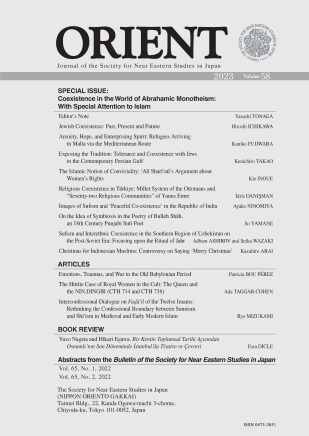Current issue
Displaying 1-14 of 14 articles from this issue
- |<
- <
- 1
- >
- >|
SPECIAL ISSUE: Coexistence in the World of Abrahamic Monotheism: With Special Attention to Islam
-
Article type: research-article
2023 Volume 58 Pages 1-5
Published: March 31, 2023
Released on J-STAGE: May 10, 2024
Download PDF (87K) -
Article type: research-article
2023 Volume 58 Pages 7-27
Published: March 31, 2023
Released on J-STAGE: May 10, 2024
Download PDF (116K) -
Article type: research-article
2023 Volume 58 Pages 29-36
Published: March 31, 2023
Released on J-STAGE: May 10, 2024
Download PDF (78K) -
Article type: research-article
2023 Volume 58 Pages 37-50
Published: March 31, 2023
Released on J-STAGE: May 10, 2024
Download PDF (338K) -
Article type: research-article
2023 Volume 58 Pages 51-62
Published: March 31, 2023
Released on J-STAGE: May 10, 2024
Download PDF (136K) -
Article type: research-article
2023 Volume 58 Pages 63-77
Published: March 31, 2023
Released on J-STAGE: May 10, 2024
Download PDF (148K) -
Article type: research-article
2023 Volume 58 Pages 79-89
Published: March 31, 2023
Released on J-STAGE: May 10, 2024
Download PDF (105K) -
Article type: research-article
2023 Volume 58 Pages 91-102
Published: March 31, 2023
Released on J-STAGE: May 10, 2024
Download PDF (107K) -
Article type: research-article
2023 Volume 58 Pages 103-125
Published: March 31, 2023
Released on J-STAGE: May 10, 2024
Download PDF (161K) -
Article type: research-article
2023 Volume 58 Pages 127-135
Published: March 31, 2023
Released on J-STAGE: May 10, 2024
Download PDF (94K)
ARTICLES
-
Article type: research-article
2023 Volume 58 Pages 137-155
Published: March 31, 2023
Released on J-STAGE: May 10, 2024
Download PDF (155K) -
Article type: research-article
2023 Volume 58 Pages 157-170
Published: March 31, 2023
Released on J-STAGE: May 10, 2024
Download PDF (150K) -
Article type: research-article
2023 Volume 58 Pages 171-186
Published: March 31, 2023
Released on J-STAGE: May 10, 2024
Download PDF (158K)
BOOK REVIEW
-
Article type: research-article
2023 Volume 58 Pages 187-191
Published: March 31, 2023
Released on J-STAGE: May 10, 2024
Download PDF (73K)
- |<
- <
- 1
- >
- >|
